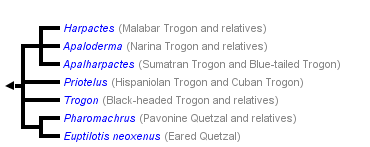Trogoniformes
Trogonidae
Trogons
John Harshman


This tree diagram shows the relationships between several groups of organisms.
The root of the current tree connects the organisms featured in this tree to their containing group and the rest of the Tree of Life. The basal branching point in the tree represents the ancestor of the other groups in the tree. This ancestor diversified over time into several descendent subgroups, which are represented as internal nodes and terminal taxa to the right.

You can click on the root to travel down the Tree of Life all the way to the root of all Life, and you can click on the names of descendent subgroups to travel up the Tree of Life all the way to individual species.
For more information on ToL tree formatting, please see Interpreting the Tree or Classification. To learn more about phylogenetic trees, please visit our Phylogenetic Biology pages.
close boxDiscussion of Phylogenetic Relationships
Old World trogons (Apaloderma, Harpactes, and Apalharpactes) clearly form a clade (Johansson and Ericson 2004, Moyle 2005; contra Sibley and Ahlquist 1990, Espinosa de los Monteros 1998), though relationships within that clade are not clear, since neither species of Apalharpactes has yet been sampled in a phylogenetic analysis. New World trogons (Trogon, Pharomachrus, Priotelus, and Euoptilotus) may be paraphyletic to the Old World trogons, though these basal relationships have been contradictory among studies (Johansson and Ericson 2004, Moyle 2005). All genera are apparently monophyletic, pending data on Apalharpactes.
References
Brightsmith, D. J. 2005. Competition, predation and nest niche shifts among tropical cavity nesters: phylogeny and natural history evolution of parrots (Psittaciformes) and trogons (Trogoniformes). Journal of Avian Biology 36:64-73.
Collar, N.J. 2001. Family Trogonidae (Trogons). Pages 80-129 in Handbook of the Birds of the World. Vol. 6. J. del Hoyo, A. Elliott, and D.A. Christie, eds. BirdLife International and Lynx Editions, Cambridge, UK and Barcelona.
Espinosa de los Monteros, A. 1998. Phylogenetic relationships among the trogons. Auk 115:937-954.
Espinosa de los Monteros, A. 2000. Higher-level phylogeny of Trogoniformes. Mol. Phylo. Evol. 14:20-34.
Johansson, U. S., and P. G. P. Ericson. 2005. A re-evaluation of basal phylogenetic relationships within trogons (Aves : Trogonidae) based on nuclear DNA sequences. Journal of Zoological Systematics and Evolutionary Research 43(2):166-173.
Johnsgard, P. A. 2000. Trogons and Quetzals of the World. Smithsonian Institution Press, Washington, D.C.
Moyle, R. G. 2005. Phylogeny and biogeographical history of Trogoniformes, a pantropical bird order. Biological Journal of the Linnean Society 84(4):725-738.
Sibley, C. G., and J. A. Ahlquist. 1990. Phylogeny and classification of birds. Yale University Press, New Haven.
Information on the Internet
- Trogon videos. Internet Bird Collection.
Title Illustrations

| Scientific Name | Trogon personatus |
|---|---|
| Location | Tandayapa Lodge, NW Ecuador |
| Specimen Condition | Live Specimen |
| Sex | Male |
| Source | Masked Trogon (male) |
| Source Collection | Flickr |
| Copyright |
© 2007 Jim Scarff

|
| Scientific Name | Pharomachrus mocinno |
|---|---|
| Location | Monteverde, Costa Rica |
| Comments | Quetzal on nest |
| Specimen Condition | Live Specimen |
| Copyright |
© Greg and Marybeth Dimijian

|
| Location | Kaeng Krachan, Thailand |
|---|---|
| Specimen Condition | Live Specimen |
| Source | Orange-breasted Trogon - Harpactes oreskios |
| Source Collection | Flickr |
| Image Use |
 This media file is licensed under the Creative Commons Attribution-NonCommercial-NoDerivs License - Version 2.0. This media file is licensed under the Creative Commons Attribution-NonCommercial-NoDerivs License - Version 2.0.
|
| Copyright | © 2008 Mike Gillam |
About This Page
Correspondence regarding this page should be directed to John Harshman at
Page copyright © 2008
 Page: Tree of Life
Trogoniformes. Trogonidae. Trogons.
Authored by
John Harshman.
The TEXT of this page is licensed under the
Creative Commons Attribution-NonCommercial License - Version 3.0. Note that images and other media
featured on this page are each governed by their own license, and they may or may not be available
for reuse. Click on an image or a media link to access the media data window, which provides the
relevant licensing information. For the general terms and conditions of ToL material reuse and
redistribution, please see the Tree of Life Copyright
Policies.
Page: Tree of Life
Trogoniformes. Trogonidae. Trogons.
Authored by
John Harshman.
The TEXT of this page is licensed under the
Creative Commons Attribution-NonCommercial License - Version 3.0. Note that images and other media
featured on this page are each governed by their own license, and they may or may not be available
for reuse. Click on an image or a media link to access the media data window, which provides the
relevant licensing information. For the general terms and conditions of ToL material reuse and
redistribution, please see the Tree of Life Copyright
Policies.
- First online 28 August 2007
- Content changed 27 June 2008
Citing this page:
Harshman, John. 2008. Trogoniformes. Trogonidae. Trogons. Version 27 June 2008 (under construction). http://tolweb.org/Trogonidae/26426/2008.06.27 in The Tree of Life Web Project, http://tolweb.org/











 Go to quick links
Go to quick search
Go to navigation for this section of the ToL site
Go to detailed links for the ToL site
Go to quick links
Go to quick search
Go to navigation for this section of the ToL site
Go to detailed links for the ToL site